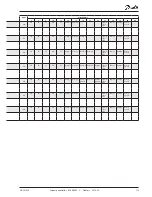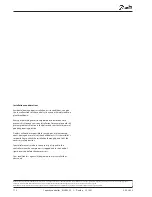
AK-CH
650
Capacity
controller RS8ER302 © Danfoss 2016-02
105
Compressor application 7 – 2 x Speed + single
The controller can control two speed-regulated compressors com-
bined with several one-step compressors that may be the same or
different in size (depending on the selected coupling pattern).
The advantage of using two speed-regulated compressors is that
it is then possible to reach a very low capacity, which is an advan-
tage with low loads while at the same time a very high variable
regulating range is possible.
Preconditions for using this compressor application are:
• Two speed-regulated compressors which can be of a different
size than the following one-step compressors
• The speed-regulated compressors can be the same or different
sizes (depending on the choice of coupling pattern)
• The same frequency band for both speed-regulated compressors
• One-step compressors of the same or different sizes (depending
on the choice of coupling pattern)
This compressor combination can be handled in accordance with
the following coupling patterns:
• Sequential
• Cyclical
• Best fit
Handling the speed-regulated compressor.
For more information on the general handling of the speed-regu-
lated compressors, refer to section "Power pack types".
Cyclical operation - example
Here the speed-regulated compressors are the same size
The one-step compressors should also be the same size.
The speed-regulated compressor is always the first to start and the
last to stop.
The capacity-regulated compressors cut in and cut out in accord-
ance with the operating time (First-In-First-Out principle).
The speed-regulated compressor is used to fill the capacity gaps
between the following one-step compressors.
Example:
Increasing capacity:
- The speed-regulated compressor with the least operating hours
(C1) starts when the desired capacity equals the start speed
- The following speed-regulated compressor C2 is cut in when
the first speed-regulated compressor (C1) has reached max.
speed (60 Hz) so that the compressors run in parallel.
- When the two speed-regulated compressors reach full speed
(60 Hz) the one-step compressor with the fewest operating
hours is cut in (C3)
- When the two speed-regulated compressors again reach full
speed (60 Hz) the last one-step compressor cuts in (C4)
- When one-step compressors are cut in , the speed is reduced
on the speed-regulated compressor (35 Hz) equivalent to the
cut in capacity.
Decreasing capacity:
- The one-step compressor with the most operating time (C3)
is cut out when the speed-regulated compressor reaches min
speed (25 Hz)
- When the two speed-regulated compressors again reach min
speed (25 Hz), the last one-step compressor is cut out (C4)
- When the two speed-regulated compressors again reach min
speed (25 Hz), the speed-regulated compressor with the most
operating hours is cut out (C1)
- The last speed-regulated compressor (C2) is cut out when the
requirements for this are fulfilled
- When one-step compressors are cut out, the speed-regulated
compressors’ speed increases (50 Hz), equivalent to the cut out
capacity.
Best fit - examples
Here, either the two speed-regulated compressors are of different
sizes, or the following one-step compressors are of different sizes.
The speed-regulated compressors are always the first to start and
the last to stop.
The capacity distributor cuts in and cuts out both speed-regulated
and one-step compressors in order to reach the best possible
capacity adjustment (least possible capacity jump).
Example 1
In this example, the speed-regulated compressors are of the same
size and the following one-step compressors are of different sizes.
Increasing capacity:
- The speed-regulated compressor with the least operating hours
(C1) starts when the desired capacity equals the start speed
- When the first speed-regulated compressor (C1) has reached
max. speed (60 Hz), the second speed-regulated compressor
(C2) cuts in so that the compressors run in parallel
- When the two speed-regulated compressors reach full speed
(60 Hz), the small one-step compressor (C3) is cut in
- When the two speed-regulated compressors again reach full
speed (60 Hz), the large one-step compressor (C4) is cut in and
the small one-step compressor (C3) is cut out
- When the two speed-regulated compressors again reach full
speed (60 Hz), the small one-step compressor (C4) is cut in
again.
- When the one-step compressor is cut in, the speed is reduced
on the speed-regulated compressor (35 Hz) corresponding to
the cut in capacity
Decreasing capacity:
- The small one-step compressor (C3) is cut out when the speed-
regulated compressor reaches the min. speed (25 Hz)
- When the two speed-regulated compressors again reach min.
speed (25 Hz), the big one-step compressor (C4) is cut in and
the small one-step compressor (C3) is cut out
- When the two speed-regulated compressors again reach min.
speed (25 Hz), the large one-step compressor (C4) is cut out
and the small one-step compressor (C3) is cut in
- When the two speed-regulated compressors again reach min
speed (25 Hz), the speed-regulated compressor with the most
operating hours (C1) is cut out (C1)
- The last speed-regulated compressor (C2) is cut out when the
requirements for this are fulfilled
























